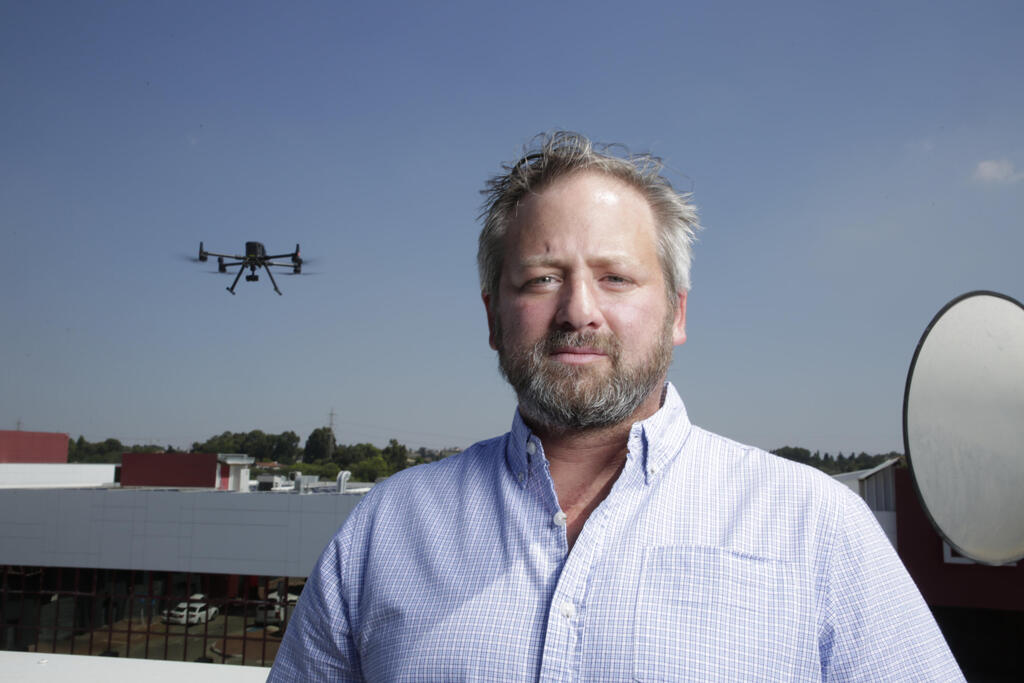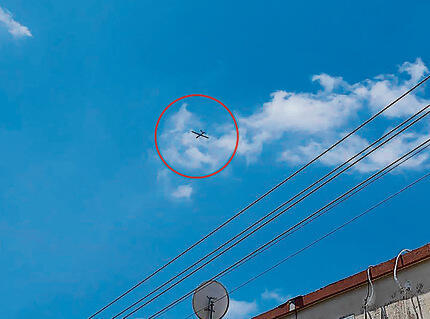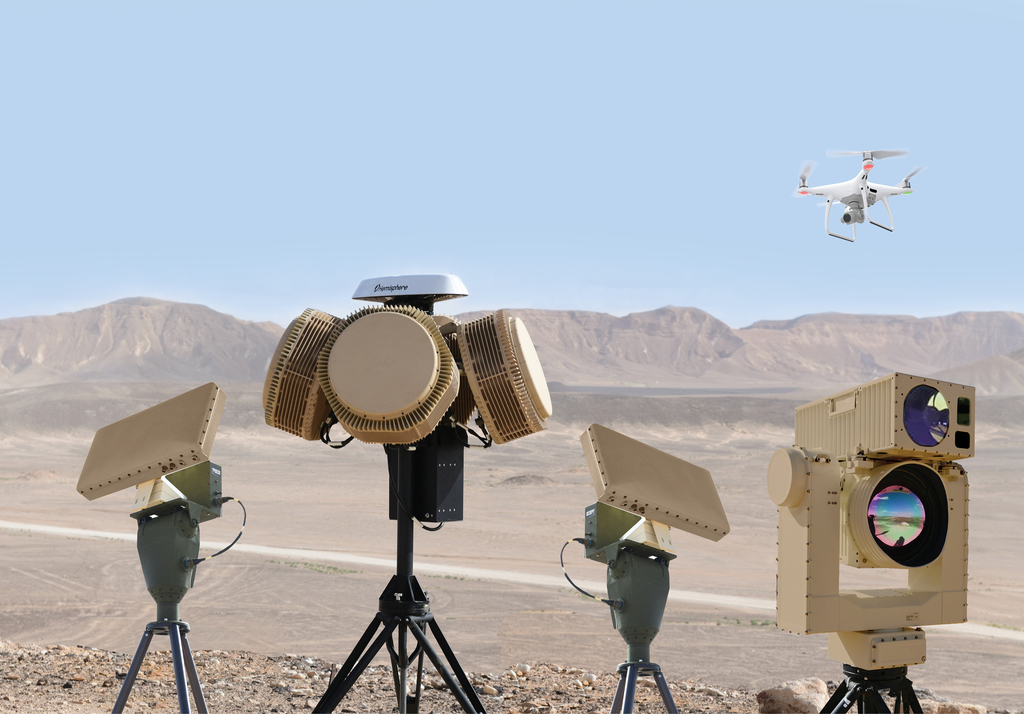"We're definitely in a drone war," says Lior Segal, co-founder and CEO of Third Eye, a company that developed an optical system combining artificial intelligence to detect drones. The system is already in operational use by the IDF.
While the company, a small firm with a 2023 sales turnover of NIS 15 million ($4 million), may have flown under the radar before, recent events have propelled it into the spotlight.
Since the outbreak of the current war, the company’s stock, listed on the Tel Aviv Stock Exchange, has surged 100%, largely due to its involvement in the increasingly critical drone defense sector.
"The big jump came after October 7, when our system was adopted by the IDF," said Segal, 44. "Our electro-optical system's uniqueness lies in its ability to detect more challenging objects, such as low-flying drones with minimal thermal signatures."
Traditionally, radar was the standard tool for detecting airborne objects by transmitting radio waves that bounce off targets. In contrast, the electro-optical system relies on two cameras—one thermal, detecting heat emissions, and one that captures light reflections. While radar has a longer detection range, it can be exposed by the radio waves it emits. The electro-optical system is portable, cheaper and more effective in detecting slow-moving drones.
Since October 7, Third Eye has received orders worth NIS 40 million ($11 million) from the Defense Ministry, with each system priced at several hundred thousand shekels.
The company went public in March 2021 with an initial valuation of NIS 112 million ($30 million) but struggled to turn a profit in its early years. By December 2022, its stock price had fallen from $1.9 to a low of $0.51. However, the war has revitalized the company's fortunes, bringing its value back to its original level.
'Drone have opened up a whole new world'
Third Eye was founded in 2010 by Lior Segal, Yoel Motola and Gil Barak. Segal explains how his military background shaped the idea: “I served in the Paratroopers and Motola in the Maglan unit. Later, I became a commander in the Oketz unit. I studied law and economics and started my career in a high-tech law firm.
“The idea for the company emerged from the challenges Motola and I faced in military service—the difficulty of identifying the enemy in urban warfare. This drove us to seek technological solutions, and with a thermal detector, we created a kind of ‘third eye’ to alert soldiers when they were about to encounter enemies."
How have drones transformed the battlefield?
“They’ve opened up a whole new world. On October 7, we saw that, thanks to observation drones, Hamas knew exactly where you were and where you were headed. These are intelligence systems Hamas couldn’t have dreamed of before, and it changes the whole operational landscape. Israel has been conducting aerial reconnaissance for decades, and suddenly the other side has similar capabilities using cheap drones bought on AliExpress—not to mention explosive drones. It’s a revolution. ISIS was the first to adopt this technology, while modern armies lagged behind."
How do you explain this?
“Armies find it harder to adopt civilian technologies because they’re perceived as less reliable. The military wants systems that work 24/7 in all weather conditions, with 100% performance. For a terrorist organization, it doesn’t matter if they achieve 70% accuracy. They don’t care if the drone hits house number 6 or 8 in Nahariya. The IDF should have calculated: what is the enemy gaining by using something we are not? I think we underestimated the impact drones would have, despite seeing their damage in Ukraine.”
Segal recalls a conversation with a NATO official who said Israeli defense industries declined an invitation to a NATO conference on how to deal with drones targeting armored vehicles. “They said, ‘Thanks, but no need.’ But we looked at what was happening in Ukraine and realized the potential. The defense establishment thought it already had the solution—GPS jamming systems. But for Hamas or Hezbollah, even imprecise strikes are effective. It turns out that even primitive methods are highly efficient on the battlefield."
Asked if Israel maintains a technological advantage, Segal isn’t so sure: “I’m not convinced Israel has technological superiority in navigation without GPS, compared to Iran. Their engineers are behind much of the drone technology we’re seeing. Hezbollah isn’t really developing these systems—their engineers are just painting the drones.”
But there are reports Israel is developing a laser-based counter-drone system.
“Before the laser is ready, I think we need to bring back classic anti-aircraft missiles as a key part of the defense against drones. We’re treating lasers as a magic solution, but it’s just one tool. It’s an expensive system that takes time to produce. As part of a broader defense strategy, it’s nice to have, but not as the sole solution. We’ve seen expensive systems like the observation balloon at Golani Junction, which cost hundreds of millions, become targets for the enemy and get knocked out. Even if the laser were perfect and cost just a million dollars, you’d still need hundreds of them. If it costs tens of millions and you only get six, it’s not the answer. You need a variety of solutions, including optical systems, which are harder to destroy even if their range isn’t ideal. If the enemy knocks out your radar, you still have a backup."
So what you’re saying is that the defense establishment is still stuck in the same mind frame even after October 7?
“The defense establishment tends to bet everything on one solution, like the sophisticated electronic border fence at Gaza. When that fence was neutralized, we were left with nothing. If we had also deployed anti-drone systems, barbed wire and manned positions with control over the fire zones—yes, World War I tactics—we’d be looking at a different situation."
"A healthy ecosystem needs companies of all sizes, and that doesn’t exist today. Compared to the big players, we’re getting the 'leftover money.'"
Segal believes that innovation is key, and startups need more support: “Israel needs to embrace more innovative technologies from small companies. In the U.S., a law mandates that 20% of the defense budget for development and procurement must go to small and medium-sized companies. I don’t expect to get as much funding as giants like Elbit or Rafael, but if you allocate more than a few small percentages to the startups, you’ll see a bigger return on investment and better resilience.
“For example, Intel is in a fragile position right now, but it’s the largest employer in Israel. The state invested billions of our tax money in it, and if it shuts down, the damage will be huge. We’re too dependent on a few big players, and that’s true for the defense industry as well. You don’t see many mid-sized companies left in the defense sector; most have been gobbled up by the big dogs."
Segal also points to barriers small companies face in securing contracts: “We once entered a tender where the minimum revenue requirement was NIS 15 million for three consecutive years. That automatically limited the competition to just three big companies. The contracts we received kept us afloat but didn’t allow us to grow.
"A healthy ecosystem needs companies of all sizes, and that doesn’t exist today. Compared to the big players, we’re getting the 'leftover money.' The large industries always claim they work with startups—I’d love to know which ones. In fact, no significant defense companies have emerged in recent years without being controlled by one of the big players, except for RADA, but it’s owned by a foreign company. I’m not talking about companies like Bet Shemesh Engines or Ashkelon Industries, which manufacture products. I’m referring to companies that come with a solution to a problem."
Despite these challenges, the war has provided an opportunity: “After October 7, we received significant orders from the Defense Ministry, which changed everything for us. Israel is a unique country—80% of the sales for large defense industries are for export, but you can’t export if you don’t establish a domestic market first. The war has allowed us to break into international markets because our products now have operational experience with the IDF.
"This year, we received orders worth NIS 40 million from the Defense Ministry. For us, that’s huge. I have an advantage: our cost structure is cheaper. We’ve gotten used to working with less. There was a tender where I competed against the three major players (Elbit, IAI, Rafael) and won, because we’re leaner, and our costs are much lower. Rumor has it we were a third cheaper. You could say that in the field of optical detection, we are now a dominant player in Israel."
"The fact that on October 8, no one picked up the phone to call military attachés and ask what drone defense solutions exist in their countries is baffling."
Do you encounter different reactions when you attend exhibitions or meet clients abroad?
"There’s been a phenomenal shift abroad. I just returned from an exhibition, and anyone who hears, 'I have an optical solution not based on radar or frequency detection,' is attentive and eager. And if you mention that you have operational experience with the IDF, even more so.
“Today, foreign clients have a deeper understanding. The situation in Ukraine has changed the landscape. We recently met a company working on vehicle protection for NATO, and they understand that today's challenge is also detecting drones and installing systems on vehicle roofs.
“Part of today’s defense strategy involves drone detection. There’s a real understanding that I hadn’t encountered before. Think about it—we began developing this system in 2019. I presented it at an exhibition in the U.S., and they looked at me like, 'What do you want?' I remember the strange looks: 'Why is your system looking at the sky? Are you searching for enemy soldiers up there?'"
What if peace comes?
What solutions could work against drones until the laser system is ready?
"The fact that on October 8, no one picked up the phone to call military attachés and ask what drone defense solutions exist in their countries is baffling. The Americans have set up an anti-drone system at the Gaza pier. The Germans have a system as well. I don't understand why an anti-aircraft battery wasn't deployed to protect the observation balloon at Golani Junction or other sites.
“Right now, in Ukraine and the global arms market, the most sought-after product is Soviet-era anti-aircraft guns from the mid-1960s. They’ve been retrofitted with electric motors, connected to radar, and are being used effectively to shoot down drones. The Ukrainians are using these guns day and night, with high interception rates. It’s absolutely effective—not perfect, but it works.
"If drones reached Givat Avni and Nahariya, that means they traveled a long distance within Israel. They could have been intercepted by anti-aircraft systems. I think there’s a lack of maturity in the defense establishment to accept that some technologies, like Iron Dome, don’t solve every problem. Sure, the Air Force is shooting down drones with F-35s, but that doesn’t seem like a logical or economical way to operate. The cost of stopping the Iranian attack was between NIS 4 to 5 billion ($1.1-1.35 billion). There’s a financial issue here, and we need the maturity to acknowledge that sometimes, we don’t need the best of the best. You don’t need an F-35 to take down drones costing NIS 20,000 to 40,000 ($5,500-11,000), and there won’t always be a jet available to deal with every drone. We’re starting to wake up to this reality now. The fact is, 11 months after October 7, we still don’t have a solid solution for drones. While the IDF has made significant improvements in detecting drones, is it really logical for the Air Force to use $2 million AMRAAM missiles to take them down?
"My logic tells me the Defense Ministry should fund and support a range of solutions, not just chase after one major system or company like the one developing the laser (Rafael, in collaboration with Elbit). Even if it’s the coolest thing on the market, or Iron Dome, there needs to be a broader approach. In the civilian world, they’ve realized the need for multiple suppliers. We need a lot of companies, and we need to give them enough orders not just to survive, but to grow."
The company finished 2023 with a loss of NIS 500,000 ($135,000) and the first half of 2024 with a loss of NIS 3.5 million ($945,000), including a revaluation of options that contributed to a loss of NIS 1.5 million ($405,000).
How has working with the Defense Ministry helped your company?
"Currently, my order backlog stands at NIS 35 million ($9.5 million), which is excellent compared to our 2023 turnover. 90% of our orders are from the Defense Ministry, and we also have a pilot project with two NATO countries, which holds great potential for future exports. In the first half of 2024, 67% of our revenue came from ground-based drone detection systems, with the rest from aerial detection systems. We expect revenues to reach NIS 40 million by 2025."
What will you do if peace comes and there’s no longer a demand for drone detection systems?
"If global peace comes, I’ll be happy. But if war comes, I’ll profit."





